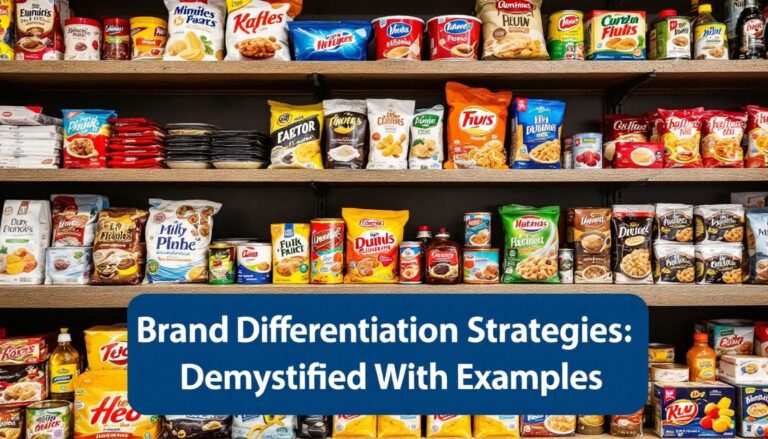Struggling to make your brand stand out? It’s not easy—competition is everywhere. But there’s a way to rise above the noise. The right Brand Positioning Strategies can help you connect with customers and keep your business unique in any market. By identifying your unique selling proposition, you can truly differentiate your brand from competitors. Implementing the top brand repositioning strategies will allow you to adapt to changing market dynamics while maintaining a strong connection with your audience. Emphasizing authenticity and storytelling can further enhance your brand’s appeal, making it more relatable and memorable.
Let me walk you through it.
Key Takeaways
- Brand positioning makes your business stand out by showing its unique value. It builds trust, loyalty, and strong customer connections.
- Key strategies include focusing on quality, price, customer service, convenience, or social media to meet audience needs. Examples like Tesla and Nike highlight success through clear positioning.
- Creating a strong Unique Value Proposition (UVP) is essential for defining what sets your brand apart from competitors and solving customer problems better.
- Testing strategies using KPIs like brand recall, website traffic, or Net Promoter Scores helps track success and refine approaches for better results.
- Regularly analyzing competitor gaps and consumer feedback ensures the strategy stays effective in changing markets over time.
Best Brand Positioning Strategies for Elevating Your Brand

A strong brand positioning strategy sets your business apart and defines how customers see your product or service. It shapes perception, builds loyalty, and creates a lasting impression in the marketplace.
What is brand positioning?
Brand positioning refers to how a brand sets itself apart in customers’ minds. It creates a unique identity using tone, imagery, and messaging. This process makes the brand stand out from competitors by showing its value or benefits clearly.
Positioning shapes perception and builds loyalty. A well-defined position drives buying behavior and strengthens trust. It ensures the audience sees the brand as the best choice in a crowded market.
Why is brand positioning important?
It sets your brand apart. I gain a competitive advantage by showing the unique value my brand brings to customers. This helps me create a strong, clear identity in the market. It also keeps customers loyal and builds trust, leading to long-term retention.
Strong positioning supports pricing strategies too. By highlighting quality or innovation, I justify premium prices without starting price wars with competitors. It boosts revenue growth and ensures my marketing efforts are more effective.
Clear brand positioning ties directly into choosing the right strategy for success next….
Types of Brand Positioning Strategies
A strong brand positioning strategy sets your business apart from competitors. Different methods focus on pricing, quality, customer care, or convenience.
Quality-based positioning strategy
I focus on products with superior quality. This strategy works best for brands offering craftsmanship, sustainability, or high-end features. Customers often pay more when they value quality over cost.
For example, luxury cars like Tesla show how innovation tied to sustainability creates appeal.
Not all customers choose premium prices. Some prioritize affordability instead. High-quality positioning offers strong returns but demands consistency in product performance and brand reputation.
A clear message about the value must connect with buyers who seek reliability and excellence.
Price-based positioning strategy
I position a brand as the most affordable choice by focusing on low prices. This works well in markets where cost drives decisions, like budget airlines or discount stores.
Low prices can attract more buyers, but they also bring risks. Cheap products may seem lower quality to some customers. Inflation and rising costs make it harder to keep prices down long-term.
Price wars harm profits quickly, especially in industries with tight competition.
Customer service positioning strategy
I focus on customer service to build emotional connections with people. This makes my brand distinct from others. By offering reliable and friendly help, I ensure customers think of my company positively.
Clear and consistent messaging during every interaction strengthens trust in the brand.
Meeting customer expectations is key to loyalty. I emphasize how my service excels beyond competitors in my brand positioning statement. This encourages clients to choose me over other options.
Strong service quality enhances the value of the brand while keeping consumers happy and engaged long-term.
Convenience-based positioning strategy
I make products easy to access, saving time for my customers. This strategy shows them my brand values their convenience and needs. Amazon’s fast delivery is a clear example—its Prime service offers one-day shipping to millions of users.
By focusing on efficient service, I build trust and loyalty among my buyers. Customers return because they know they can rely on me. This approach creates strong brand awareness while ensuring satisfaction at every step.
Social media positioning strategy
Building a strong social media positioning strategy matters. I focus on shaping how customers view my brand through attractive visuals, engaging content, and clear behavior online.
Staying true to my brand values keeps trust alive with followers.
I monitor customer feedback daily to adapt quickly. Tracking sentiment lets me know if people like or dislike my posts or campaigns. Consistency in tone and messaging across platforms makes my brand more recognizable over time.
Steps to Create a Winning Brand Positioning Strategy
Start by focusing on what makes your brand unique. This will help you stand out and attract the right audience.
Understand your target audience
I focus on understanding my target audience by studying their interests, values, and struggles. I analyze psychographics, not just demographics, to see what drives them. For example, I explore hobbies, spending habits, or key issues they care about.
To create detailed buyer personas, I rely on market research tools and data analysis. Surveys and customer interviews help me gather insights fast. Staying updated on trends ensures my messaging stays relevant—this keeps the brand connected with their needs.
Next up: Analyze your competitors.
Analyze your competitors
I study how competitors position their brand in the market. I check what value their brand brings and which customer needs they focus on. I look for gaps in their strategies—such as missing features, weak marketing messages, or poor service offerings—that I can use to set my brand apart.
I also track their pricing models, advertising campaigns, and social media positioning. This helps me see where my unique value proposition can stand out. By understanding this thoroughly, I can create a powerful strategy that positions my brand above others while staying ready for the next steps: defining my unique offering.
Define your unique value proposition
I pinpoint what sets my brand apart after studying competitors. My unique value proposition (UVP) tells why customers should pick my brand over others. It highlights the clear benefits I offer and how I solve their problems better than anyone else.
To craft an effective UVP, I focus on identifying offerings that stand out. I keep it simple, focusing on benefits instead of features. It’s a process of refining based on customer feedback to ensure clarity and relevance.
A strong UVP ensures my brand stays memorable and competitive in the market.
Craft a clear brand positioning statement
I define my brand’s position using a clear structure. For example, “For [target market], our brand is the only one among all [competitive set] that [unique value claim] because [reasons to believe].” This helps me stay focused and communicate exactly what sets my brand apart.
VOSS shows how it works. They target premium water buyers by offering sleek bottles and pure quality—making them unique in the bottled water space. I make sure to align this statement with my marketing goals for consistency across all touchpoints.
Test and refine your strategy
I test my brand positioning using surveys, focus groups, and social media polls. Measuring key indicators like awareness levels, customer perception, and revenue growth helps me track success.
Feedback shows if the brand message connects or needs changes.
I stay flexible by improving based on research and feedback loops. For instance, shifts in customer preferences guide updates to my strategy. Small adjustments often create big impacts in maintaining a strong market position while meeting audience needs.
Examples of Successful Brand Positioning
Strong brand positioning makes you stand out. Real-world examples show how smart strategies create lasting impressions.
Tesla: Sustainable innovation
I see Tesla leading with eco-friendly electric cars. The brand pushes to speed up the shift to clean energy. Its mission is clear—build a sustainable future. I admire how their focus on advanced technology sets them apart from traditional car makers.
Tesla’s vehicles use no gas, lowering carbon footprints for drivers like me. Their innovation goes beyond cars, too—they invest in solar panels and batteries. This makes Tesla a symbol of green solutions, meeting growing demands for sustainability worldwide.
Nike: Inspiring action and motivation
Nike pushes people to aim higher. Their mission drives this—”to inspire and innovate for every athlete,” anyone with a body. I feel their ads spark self-belief, like the “Find Your Greatness” campaign.
Their campaigns focus on action and heart. Colin Kaepernick’s ad showed courage, promoting change through choice. Nike builds a strong brand identity by mixing powerful messages with sleek design and bold storytelling, making “Just Do It” unforgettable.
Starbucks: Personalized customer experiences
I see how Starbucks focuses on creating personal connections. Baristas greet customers by name and recall their favorite drinks. This makes me feel appreciated every time I visit.
The brand fosters emotional bonds through its “Personal Experience” approach, aiming for stronger connections with people. During holiday seasons, Starbucks evaluates results by analyzing sales and customer loyalty.
Patagonia: Purpose-driven branding
Patagonia shows how a brand can stand for more than products. Founded in 1973 by Yvon Chouinard, it focuses on environmental change. The company donates 1% of sales to grassroots causes and encourages sustainability through actions like its “Don’t Buy This Jacket” campaign.
That ad urged people to repair gear rather than replace it.
Its mission is clear—save the planet. Every move reflects this purpose, from using recycled materials to fighting climate issues. By aligning values with action, Patagonia has become a trusted name.
Customers see it as more than just outdoor gear; they view it as an ally in protecting nature.
Overcoming Common Brand Positioning Challenges
Positioning your brand can be tough—stay focused on standing out and staying consistent to succeed.
Differentiating in a saturated market
I focus on what sets my brand apart. I highlight my unique value proposition to show why it’s the best choice. Emotional branding plays a big role here—I connect with customers by tapping into their needs and desires.
Consistency builds trust. I ensure every message aligns with the brand promise. Adapting quickly keeps me ahead of shifting trends, ensuring relevance in crowded spaces like social media or retail markets.
Balancing price and quality perception
I balance price and quality by aligning customer needs with value. Higher prices reflect superior quality, appealing to those who seek excellence. Affordable pricing attracts budget-driven buyers without sacrificing key features.
I also focus on defining a strong Unique Value Proposition (UVP). This ensures my brand stands apart with clear offerings. For example, showcasing durable products at competitive prices strengthens trust while satisfying diverse audiences.
Maintaining consistency across touchpoints
I ensure my brand looks and feels the same everywhere. Clear brand guidelines help me do this. I use them for logos, colors, and messaging. These rules make sure every ad, email, or post stays on-brand.
Consistent communication builds trust with customers. I check all materials reflect my unique value clearly. Regular feedback from users keeps me aware of changes needed to stay aligned with their expectations.
Measuring the Success of Your Brand Positioning Strategy
Track how customers view your brand and monitor sales growth. Use data to adjust and improve your approach for better results.
Key performance indicators (KPIs) to track
I use specific KPIs to measure the success of my brand positioning strategy. These metrics show how well customers perceive the brand and its value.
- Measure unaided and aided recall to check brand awareness. This shows if people recognize my brand without hints or with a small prompt.
- Monitor website traffic using Google Analytics. Direct visits indicate strong interest in my brand.
- Track the social share of voice on platforms like Twitter and Instagram. Brand mentions prove if my efforts grab attention online.
- Use customer loyalty metrics, including retention rates and Net Promoter Scores (NPS). These reveal how satisfied customers are with their experience.
Next, I focus on testing strategies for improvement.
Adjusting strategies based on consumer feedback
To improve my brand positioning, I analyze consumer feedback regularly. Data shows that market research every 6-12 months helps me track customer needs and trends. Feedback reveals how customers perceive my brand or product compared to competitors.
I act on this information by refining messaging or adjusting services. If reviews highlight slow delivery, I tweak supply chains for faster shipping. Positive comments about specific offerings guide where to focus more effort.
These steps ensure my strategy stays effective and connects with the audience deeply.
Conclusion
Brand positioning sets a business apart. A clear strategy attracts the right customers and boosts loyalty. Strong examples like Nike or Starbucks prove it works. Focus on your unique value to win the market.
Test, adapt, and let your brand shine!
References
- https://www.smashbrand.com/articles/what-is-brand-positioning/
- https://www.smartsheet.com/content/brand-positioning?srsltid=AfmBOoqvWOhPPy4XZNJhEqPCX8b-96blq9CN00kihhVDfTYUpAvp1sSj
- https://www.smartsheet.com/content/brand-positioning?srsltid=AfmBOoobt1t0lKjwCirhzw6mISQG4QqUhkMJG9FD5yPGDbwUhVzz4Hwz
- https://www.smartsheet.com/content/brand-positioning?srsltid=AfmBOooYFI2qAUIE6W6VJE4TtzV3l7uCtMsQh7Un0zmmSdev2kHjwb3j
- https://www.smartsheet.com/content/brand-positioning?srsltid=AfmBOorDX4p3r5mKdWnGzYj-hhaRwUK0UuVnCL48wF3PCbEtjg7yEiyK
- https://www.smartsheet.com/content/brand-positioning?srsltid=AfmBOopTq3LDCbDwalL9mxt3WFthIx1mQo44j8s8PL8RA0gbGUdBvtrp
- https://www.agorapulse.com/blog/social-media-marketing/social-media-positioning/ (2022-09-27)
- https://www.smashbrand.com/articles/brand-positioning-strategy/
- https://www.askattest.com/blog/articles/positioning-strategy (2024-04-10)
- https://www.mtrmarketing.com/blog/crafting-your-unique-value-proposition-and-brand-positioning-statement-standing-out-in-a-crowded-market (2024-02-14)
- https://online.hbs.edu/blog/post/brand-positioning-statement
- https://www.canny-creative.com/create-brand-positioning-statement/ (2020-10-15)
- https://www.smartsheet.com/content/brand-positioning?srsltid=AfmBOor_bcHc-Y5d3tRZ4WqiA1A1ONTtmX4sr2sjQJf78boyxzrJRCMB
- https://www.linkedin.com/pulse/art-positioning-from-teslas-triumph-new-cokes-fizzled-abhishek-bajpai-haxrc
- https://www.empathymarketing.co/blog/nike-brand-strategy-positioning (2024-03-10)
- https://www.laughlin.com/news/starbucks-personalization
- https://designstripe.com/blog/patagonias-brand-impact
- https://melonbranding.com/branding/brand-positioning-challenges-and-strategies-you-can-implement/
- https://www.smartsheet.com/content/brand-positioning?srsltid=AfmBOop_0o2FHo5sXhOmfvrEtcopRvys_5ya2JprJRqRPCZLT7LMSj6-
- https://robertbogere.com/effective-types-brand-positioning-strategies/
- https://www.huebnermarketing.com/measuring-brand-positioning-success-key-metrics-and-analytics/ (2023-08-29)
- https://www.smartsheet.com/content/brand-positioning?srsltid=AfmBOoot4U67xHc47CTWmHxVHt-kUnFvZYNO3CrqjzDFPrMvFSMZdvlt







